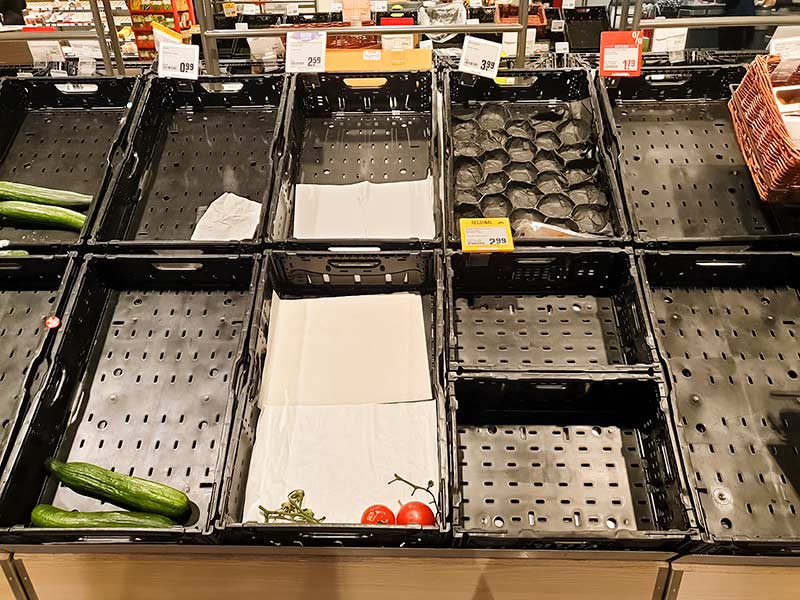FDIC-Insured - Backed by the full faith and credit of the U.S. Government
-
-

-
Stacey Cole
Vice President, Agribusiness BankingJan 14 2021
-

Agribusiness Takes on the COVID-19 Punches
Author: Stacey Cole, Vice President, Agribusiness Banking
Throughout 2020, the COVID-19 pandemic has continued to impact the food industry in the U.S., particularly when compared to past trends. According to a report issued by McKinsey & Company in July of 2020, food consumption has historically been evenly split between retail outlets—such as grocery stores—and the food service industry, including restaurants and schools. Over the past 5 years, growth has been consistent at around 4%.
The COVID-19 pandemic quickly changed historic precedents in 2020, upending traditional patterns within a matter of weeks. The McKinsey report indicates that retail food sales rose 29% on a month-over-month basis in March as the health crisis reached American shores. Simultaneously, food sales at restaurants dropped dramatically, falling over 28% in a month as stay-at-home mandates kept consumers cloistered.
The shift created shockwaves throughout the agribusiness industry. While grocery store shelves sat empty, farmers and distributors were forced to dispose of agricultural products meant for food service outlets. Dairy distributors, for example, were left with unsold milk as schools closed and cancelled orders.
Impacts like these have been felt throughout the agribusiness industry, but as the virus continues to wage its war, American farmers and producers are adapting by finding ways to support food chains in the new and unprecedented environment.
COVID-19 Impacts the Food Chain in 2020
As the threat from the COVID-19 virus continues to linger, disruptions to the food supply chain have continued throughout the U.S. due to a variety of factors, including a shortage of labor.
To contain the spread of the virus, U.S. borders were closed to non-essential travel between Canada or Mexico, resulting in the delayed arrival of immigrant workers. The impact was felt most keenly by U.S. specialty farmers who expend 37% of their total operational expenses on immigrant workers to plant and harvest sensitive crops, such as lettuce and strawberries.
The challenges, however, didn’t end with work visa issues. Once workers began to arrive, farmers faced another set of complexities.
Activities in the field often require individuals to work within close proximity to one another, raising the threat of virus spread. While some farmers were able to adjust their operations and employ worker protections, others were not, making it difficult to harvest crops. According to Western Growers, fresh produce losses among its members could reach $5 billion this year.
Unfortunately, growers of fresh produce were not the only ones to feel the pinch of the COVID-19 virus. Since the pandemic reached U.S. shores, meat processing plants have witnessed a wave of closures as employees become too ill to work or the threat of viral spread becomes too high. Since 80% of U.S. beef is processed through only four plants, beef producers have keenly felt the impacts.
Disruptions like these affect the flow of agricultural goods and products, resulting in more than empty grocery store shelves. According to a Texas A&M AgriLife coordinated study, the impact of the COVID-19 crisis on the agricultural industry could reduce U.S. gross domestic product by $2.5 trillion and result in the loss of 19 million full-time positions.
Consumers and Farmers Adapt to Supply Disruptions
Facing empty shelves, many consumers took matters into their own hands. According to an article published by PennLive, The National Garden Bureau executive director, Diane Blazek, reported a 20-30% gain in nursery sales as consumers dug their own plots and planted gardens to shore up food supplies. By some accounts, online retailers of seeds and plant products witnessed as much as a quadruple spike in sales.[i]
An increased number of consumers reaping the benefits of their own harvest had a trickle-down impact on other industries. Sales on deep freezers in the spring resulted in supply shortages at local retailers that lasted well into the fall. Likewise, sales of canning supplies jumped through the roof as individuals prepared to package their home-grown bounty.
As a glimmer of hope begins to light the horizon in the form of a COVID-19 vaccine, the agribusiness industry continues to roll with the punches, proving remarkably resilient. Actions, such as reducing the variety of products produced to meet popular demand and finding alternative sources have ensured a continuous food supply for Americans.
Farmers and ranchers are also taking matters into their own hands to ensure food supplies reach American tables. Utilizing social media channels and organizations such as FarmShake, many producers are taking products directly to consumers.
However, for farmers and agricultural producers still suffering from the economic impacts of the COVID-19 crisis, the USDA announced in September an additional $14 billion in agricultural loans. Likewise, banks committed to the health and wellbeing of the agribusiness industry continue to partner with customers on financial solutions that promote success.
As participants in the agribusiness industry take advantage of available programs and evolve operations to meet the needs of the current crisis, they are demonstrating remarkable adaptability. It’s the type of resilience that will keep American agribusiness humming and food on everyone’s table.
About the Author
Stacey has worked at First National Bank of Omaha since 2006. She grew up on a diversified family agricultural operation in northeast Nebraska. After graduating from Creighton University with her MBA, she joined the Executive Development Program at the Bank. Stacey then returned to her agricultural roots by joining the First National Bank of Omaha’s Agribusiness Banking team, where she works with ag producers in cattle, swine, grain, feed, food processing, and other agribusiness sectors.
The articles in this blog are for informational purposes only and not intended to provide specific advice or recommendations. When making decisions about your financial situation, consult a financial professional for advice. Articles are not regularly updated, and information may become outdated.